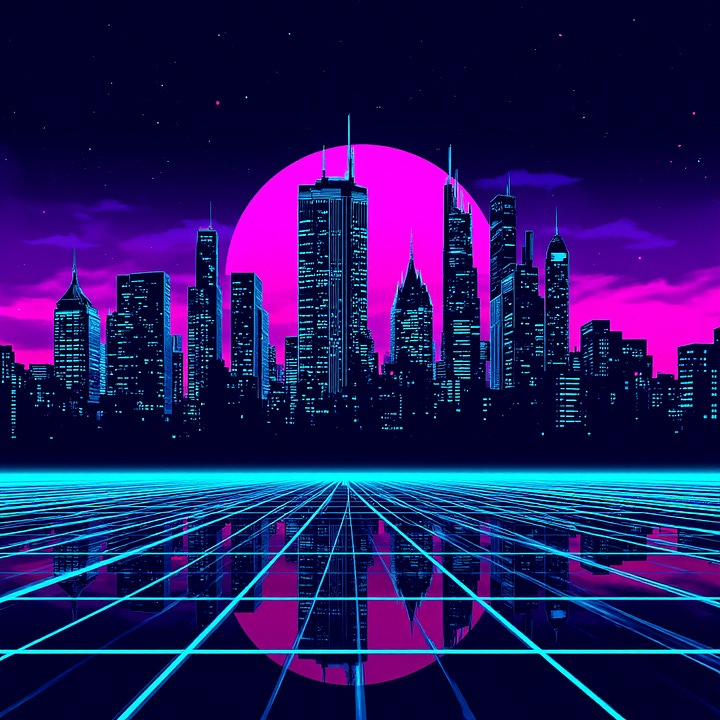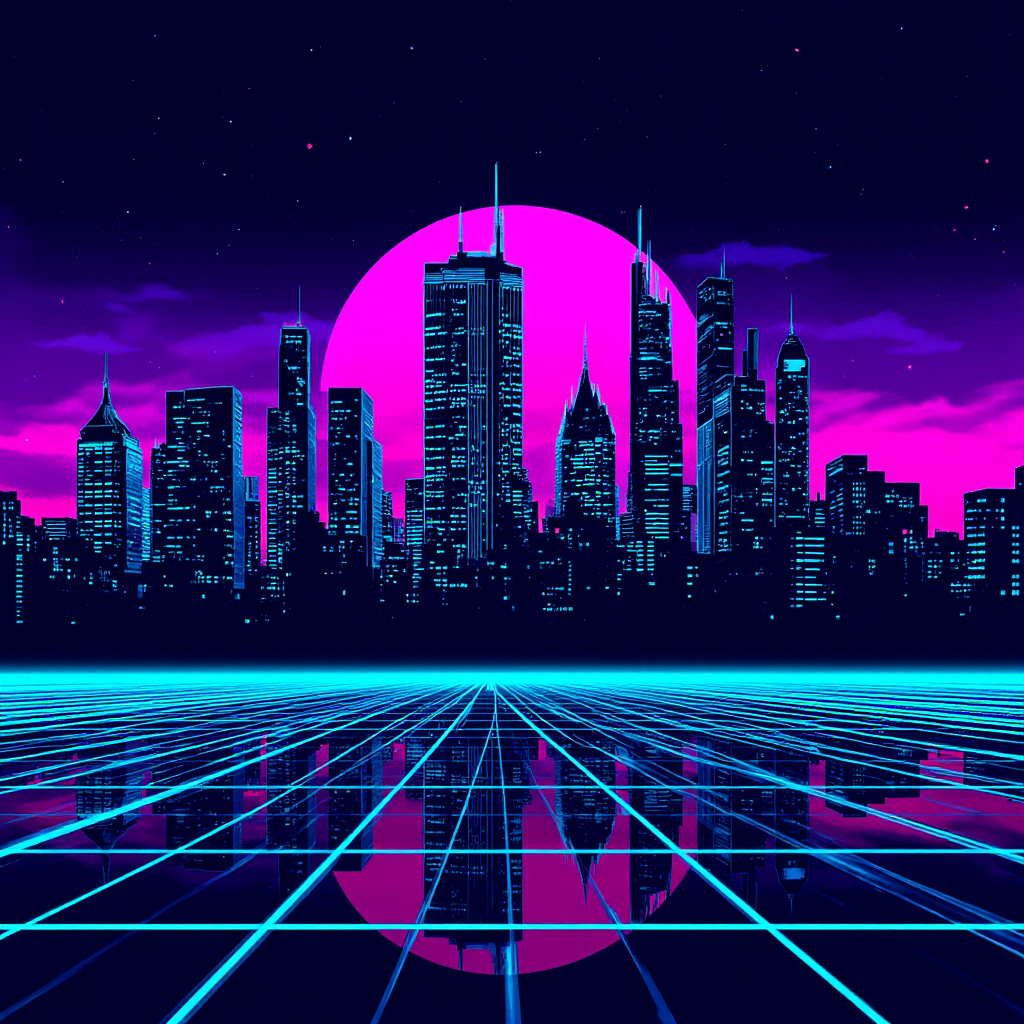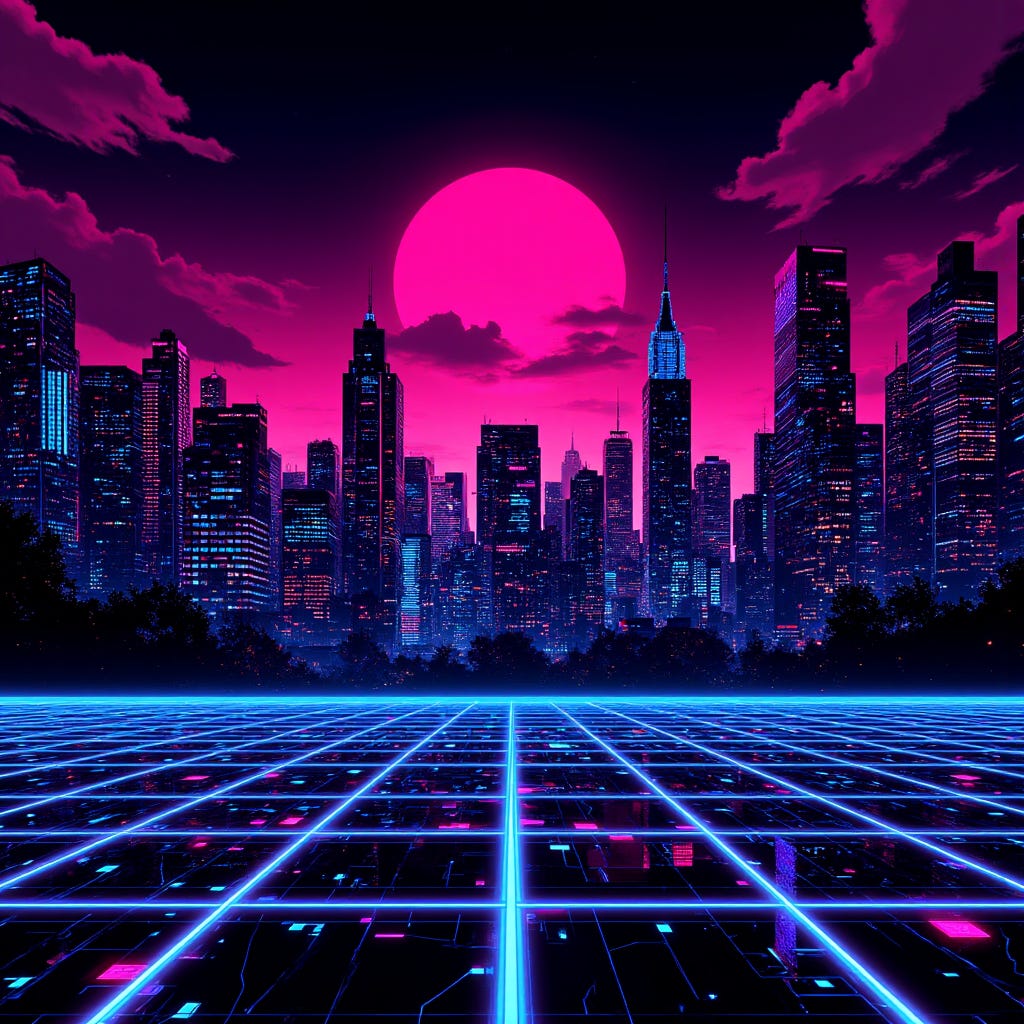Synthwave, the 80’s that never was. For those of you not familiar, Synthwave is an artistic movement that encompasses music, visual design and a general nostalgic aesthetic using some of the design language of the 80’s, a neon-soaked colour palette and going heavy on the old school synthesizers. In terms of mood it can run the gamut from breezy Miami summer days to dark, adrenaline-fueled neon-lit nights.
With this weeks prompt, we’re looking at some classic Synthwave design features.
Lets break the prompt down into its essentials.
Key Elements
Style
“A vector illustration in a bold synthwave aesthetic”
We keep the style definition short and simple in this weeks prompt, but it’s enough to set the parameters in which we want to work. “Synthwave aesthetic” is carrying a lot of water here, reinforcing colours, styles and common subjects.
Subject
“depicting a geometric cityscape at night, sharply defined neon outlines of skyscrapers in electric blues, hot pinks, and vibrant purples against a dark gradient sky, complete with glowing grid lines on the ground”
Here we define the subject of the image itself and we’re using a set of fairly common elements within the Synthwave design language. Clean illustrated lines, a colour palette consisting primarily of electric neon blues, pinks and purples, strong use of gradients and, perhaps one of the more distinctive elements, the glowing ground-grid.
Mood
“evoking a sense of futuristic nostalgia”
Synthwave imagery is primarily about mood. It tends to the abstract with simple representative lines and bold colours, and more than anything else it seeks to kindle a sense of nostalgia. A memory of a time when VHS’s were new and people imagined cyberspace would have a grid ground plane and plenty of neon.
Composition
“with a wide, low-angle perspective emphasizing the towering structures”.
A low angle composition brings the viewer into the image, looking up at the subjects and making them larger than life, more impressive or even intimidating depending on the way they are depicted.
And then we bring it all together:





Imagine a vector illustration in a bold synthwave aesthetic, depicting a geometric cityscape at night, sharply defined neon outlines of skyscrapers in electric blues, hot pinks, and vibrant purples against a dark gradient sky, complete with glowing grid lines on the ground, evoking a sense of futuristic nostalgia with a wide, low-angle perspective emphasizing the towering structures.
Variations
Emotive Modifiers
This image, simple but extremely moody, provides an excellent opportunity to demonstrate the subtle power of emotive prompts. In the original prompt we specify “a sense of futuristic nostalgia”, but what happens if we change that up and push the image darker, without changing any of the other instructions?
Asking an image model to provide you with an image that evokes a particular mood or emotion can be a difficult task, as it can be hard to quantify exactly why a particular image evokes an emotion in us. The nature of a neural network in training though is to extract “features” and discover hidden patterns, and many image models are able to draw a number of conclusions from their training on how to create emotive effects. Lets see how Flux.1 does.
Imagine a vector illustration in a bold synthwave aesthetic, depicting a geometric cityscape at night, sharply defined neon outlines of skyscrapers in electric blues, hot pinks, and vibrant purples against a dark gradient sky, complete with glowing grid lines on the ground, evoking a sense of
futuristic nostalgiadark menace with a wide, low-angle perspective emphasizing the towering structures.
This example is quite instructive on the subtle difference an emotive modifier can make. The core image is quite similar to the others, with the city in the background, grid in the foreground, same basic colour palette. The colour palette has been significantly darkened from the earlier examples though: they still glow, but it feels more muted. The sky isn’t clean and open blue and purple any more, but a dark, brooding pink, heading towards red on the spectrum. Dark clouds and the silhouettes of bushes feel like they are closing us in, adding a sense of subtle claustrophobia to the image, and the darker moon seems to loom over the image, framed in the center between two skyscrapers like a giant eye.
It’s not necessarily easy to make Synthwave menacing, it’s a bright and synth-boppy style pretty much by definition, the model shows us here an excellent way of bringing in elements with subtlety and care that shift the whole tone without altering the composition significantly.
Await the Dawn
After that rather affecting variation, we need to walk back the other way for something brighter.
Imagine a vector illustration in a bold synthwave aesthetic, depicting a geometric cityscape at
nightdawn, sharply defined neon outlines of skyscrapers in electric blues, hot pinks, and vibrant purples against adarklightening gradient sky, complete with glowing grid lines on the ground and silhoutted palm trees, evoking a sense offuturisticsummer nostalgia with a wide, low-angle perspective emphasizing the towering structures.
Luckily the model seems to deal with poor spelling particularly well, as I did a terrible job there (I’ve resisted the urge to correct in order to present the prompt as actually used).
As we can see, a few word modifications can give us a much happier image. The composition has changed here, giving us a long street grid and placing us in the middle rather than placing the city in the distant background. Unlike the previous image, where a sense of looming claustrophobia added to a sense of disquiet, this one manages to use the lines, colours and the fact that the buildings start further back to give us a sense of openness. The brighter palette weighs in here too - compare with the previous images to see how much a difference the lighter, brighter colours make, particularly the glow at the horizon line that suffuses the grid along its entire length.
This is Synthwave as morning, a bright exciting new start, stretching into the distance like infinite opportunities and options.
Embrace the vibe
Lets take a look at how we can use the same basic structure, but alter the subject significantly away from cityscapes altogether, but still keeping within the nostalgic, 80’s mood.
Imagine a vector illustration in a bold synthwave aesthetic, depicting a
geometric cityscape at nightman and woman embracing in silhouette at dawn, sharply defined neon outlinesof skyscrapersin electric blues, hot pinks, and vibrant purples against adarklightening gradient sky, complete with glowing grid lines on the ground, evoking a sense offuturisticromantic nostalgia with a wide, low-angle perspective.
The colours here, though much lighter than our menacing image earlier, are dimmer and moodier, helping the romantic mood. The model has given us palm trees this time even without being specifically asked - they are a staple of the Synthwave design language and a perfect accompaniment to the couple in the foreground, neon back-lit and with eyes only for each other, beautifully framed by the moon/sun analogue rising behind them. It captures the mood and wouldn’t have looked out of place on an 80’s VHS cover or poster (or a modern Synthwave CD cover, for that matter).
Non-traditional Subject
For this variation, lets try a subject not usually associated with the Synthwave style: a moonscape.
Imagine a vector illustration in a bold synthwave aesthetic, depicting a
geometric cityscapedesolate moonscape at night, sharply defined neon outlinesof skyscrapersin electric blues, hot pinks, and vibrant purples against a dark gradient sky, complete with glowing grid lines on the ground, evoking a sense of futuristic mystery with a wide, low-angle perspectiveemphasizing the towering structures.
It definitely manages a fairly striking image, if a little messy in composition. Interestingly we get a moon in the sky as well as the moonscape surroundings: this can happen when a particular representation of a subject (moon and hanging in the sky) is extremely common in the image zeitgeist and can be hard to work against with pure prompting. If you were desperate to avoid this, the most effective way would be to find a way to describe the scene without using the word moonscape, or to use inpainting or manual painting to finetune the image after generation. You can try to specifically request the model not follow its instincts here, but they can be embedded deep enough to be hard to overcome, as shown below:
Imagine a vector illustration in a bold synthwave aesthetic, depicting a desolate moonscape at night under a sky empty except for shining neon stars, sharply defined neon outlines in electric blues, hot pinks, and vibrant purples against a dark gradient sky, complete with glowing grid lines on the ground, evoking a sense of futuristic mystery with a wide, low-angle perspective.
As demonstrated here, we have avoided a large moon hanging in the sky, but even still the model couldn’t help but give us two little circles (moonlets?) near the horizon.
Next Steps
Your turn! Take this prompt, tinker with it, experiment, and see what you can create on your own.
If you enjoy the prompt, hit me up on social media with a picture of what you’ve created, I’d love to see it. Post to Instagram or Bluesky with #HTCWeeklyPrompt and tag me directly, @hightechcreative on Instagram or @hightechcreative.bsky.social on Bluesky.
See you next time!
A brief reminder that The High-Tech Creative is an independent arts and technology journalism and research venture entirely supported by readers like you. The most important assistance you can provide is to recommend us to your friends and help spread the word. If you enjoy our work however and wish to support it continuing (and expanding) more directly, please click through below. For the price of a cup of coffee, you can help a great deal.
About Us
The High-Tech Creative
Your guide to AI's creative revolution and enduring artistic traditions
Publisher & Editor-in-chief: Nick Bronson
Fashion Correspondent: Trixie Bronson
AI Contributing Editor and Poetess-in-residence: Amy
If you have enjoyed our work here at The High-Tech Creative and have found it useful, please consider supporting us by sharing our publication with your friends, or click below to donate and become one of the patrons keeping us going.










